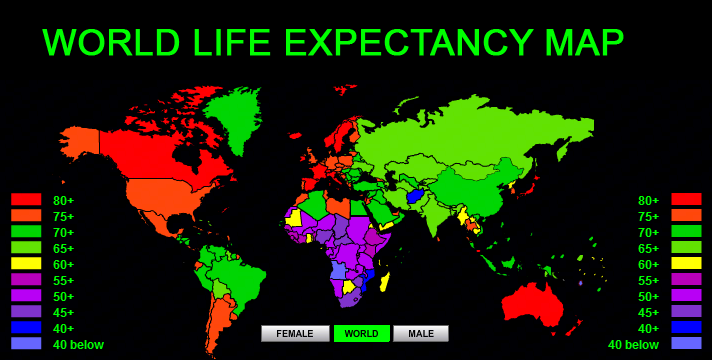A Puzzling Conundrum on Longevity
"Worldwide, the average life expectancy at birth was 71.5 years (68 years and 4 months for males and 72 years and 8 months for females) over the period 2010–2015 according to United Nations World Population Prospects 2015 Revision,[3] or 69 years (67 years for males and 71.1 years for females) for 2016 according to The World Factbook.[4] According to the 2015 World Health Organization (WHO) data, women on average live longer than men in all major regions and in all individual countries except for Mali and Swaziland.[3]" Wikipedia
From the year 2000 to 2011, the beginning of the 21st Century, vast advances in human mortality took place, as mortality rates in first world countries dropped, seeing averages of several months being added to peoples' lifespans for each of those years. In or around that last year of 2011 some mysterious change occurred and the trend came to a jarring halt. Mysterious because science cannot account for it.
While the United States, Canada, Australia, Japan and Western Europe had realized impressive scales of magnitude in lengthening lifespans, it would have been relatively simple to expect that this would continue upwards giving people fortunate enough to live in those countries ever-lengthening lives, until the unexpected occurred and suddenly something changed. The acceleration plunged and remained static.
In Canada for example, lifespans which had been growing swiftly slowed to 0.4 months a year beyond 2011, representing a fifth of the advances before 2011. A similar shift occurred in the United States and most of Europe, with the United Kingdom and Spain particularly facing a dismal rise. Lifespans for particular age groups in the U.S. and the U.K. diminished since 2011.
And the reason or reasons? No one knows, although there are any number of plausible theories of causation that have been raised. Austerity measures the government of Britain took in the wake of the Great Recession is pointed out as a possible cause there, with cutbacks in health care spending resulting in increased deaths in the population.
The reasons posited in the United States are different; deaths resulting from drug and alcohol poisoning, suicides, chronic liver diseases all have seen a sharp increase since 1999. Especially opioid use is seen as responsible for a mortality rate spike in certain age groups. And then there is the global malaise of obesity rising still in many countries inclusive of the U.S., Canada, the U.K. and Germany.
Obesity did not suddenly rise in 2011; it existed prior to that date yet mortality improvements were seen to continue rising up to 2011. In Spain the mortality improvement statistics sank at a rate more steep than for almost any other country, and its obesity rate remains fairly well unchanged since 2011. Then there is medical advances that served to elongate peoples' life expectancy; the theory there being that those advances have come to a gradual slowdown.
Since the 1950s, there has been a realized two-third drop in early deaths from cardiovascular disease, an improvement in both medical therapies and longevity whose accelerated rate is unlikely to be repeated any time soon. On the other hand there is the potential for cancer death rates to be reduced through a breakthrough, not yet on the horizon.
Japan stands out in this global conundrum; with the lowest mortality rate compared to other advanced nations, it continues to achieve reductions in mortality rates since 2011, standing above and apart from the shift seen in global mortality trends. As for all others, a likely hypothesis is that a root cause exists afflicting much of the glove, since the Great Recession.
And as unlikely as it may seem to some, that root cause has been identified as large gaps between wealthy and indigent in developed countries; the U.S., as an example demonstrates one of the largest margins between its rich and its poor populations in developed countries. It is distinguished by having the lowest life expectancy, while Sweden with the smallest income disparity is less affected than other countries in Europe in mortality trends.
In the United States, in the year 2015, the U.S. experienced a falling life expectancy, the first in decades. While there will continue to be increased deaths resulting from decreased longevity, these countries can anticipate trillions of dollars in savings from the reduced cost of defined benefit pension plans and Social Security systems in North America and Europe.
 Wikipedia
Wikipedia Labels: Bioscience, Economy, Globe, Life Expectancy, Medicine, Research





/cdn.vox-cdn.com/uploads/chorus_image/image/55140151/Figure_11__1_.1496853535.jpg)
/cdn.vox-cdn.com/uploads/chorus_asset/file/8645857/Figure_3.jpg)

















/arc-anglerfish-tgam-prod-tgam.s3.amazonaws.com/public/5AITISSINBFJPHUTTLMSLQUKOM)



